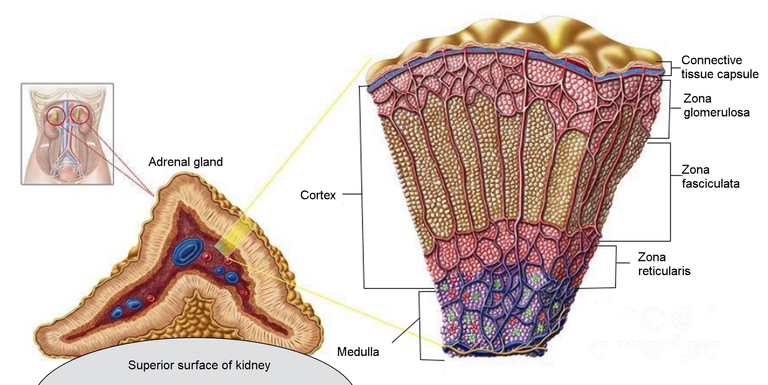A Medical Mystery: Unraveling the Case of a Young Patient with Adrenal Crisis
People present to the emergency room with different signs and symptoms. Some of the signs and symptoms would come across as illnesses that has once been treated and other would come as a medical mystery left to the medical practitioners to solve. While so many of this cases do not find their way into journal some do get written in journals and I will be discussing one of those cases today.
A young lady who is 15 years old reported to a tertiary care pediatric hospital emergency department with vague right-sided pleuritic chest pain and dizziness. Her mother stated that the lady was drinking up to 3 Liters of water a day which wasn't like her in the past who would need reminder to take water also she began craving salty foods and pickles. Upon entering into the hospital, her blood pressure was taken while she was laying down, and it measured 90/50 mm Hg. She was asked to sit up and her blood pressure was measured 80/40 mm Hg. Her heart rate was 100 beats/min, her respiratory rate was at 16 breaths/min, and she was afebrile.

With a chest X-ray, there was a pneumonia which explained the fever and cough. Blood work was done and lots of white blood cells were seen in her blood and this was consistent with pneumonia but in addition to her elevated blood white blood cells, she also had high level of creatinine and Urea, high level of potassium at (5.0 mmol/L), but her sodium level was low (133 mmol/L) even when she was said to be craving salty food and eating it in recent times.
The doctor diagnosed her with Sepsis from pneumonia (Sepsis secondary to pneumonia). Sepsis is life-threatening and it is as a result of the immune system overreacting to infection leading to inflammation and organ damage. Early recognition and treatment is key to saving a life and so broad spectrum antibiotics and IV fluids were administered so the patient would be fine but this wasn't so.
The following day, the patients blood work was done and her kidneys looked like they were back to normal but the sodium level was still low, her blood pressure low, and her potassium level were high. There can be a long list of conditions that cause blood pressure to drop as well as cause sodium to be low and they include dehydration, heart failure, pancreatitis, hypothyroidism, adrenal crisis, cardiac arrest, medication.

Physical examinations were then done on the patients including sticking out of the tongue, and it was then they found brown markings on the bottom of tongue referred to as hyper-pigmentation which then shows that coupled with the previous symptoms, it is an Adrenal crisis and this could mean that the adrenal glands are not making the hormones that they should, in a condition known as Addison's disease also known as Primary Adrenal Insufficiency. This disease can be life-threatening if not quickly treated.
The Adrenal gland sits on the kidneys with each layers responsible for producing different hormones that are responsible for life functions. Aldosterone is one of the hormones released in the adrenal gland. It is released in the Zona glomerulosa, and it regulates sodium and potassium in the kidney keeping sodium and releasing potassium out of the body. In the case of the patient, Aldosterone wasn't working properly so the patient was urinating sodium and excess water while retaining potassium.
Cortisol is released in the zona fasciculata and the lack of it led to the loss of weight, nausea, abdominal pain, and hyperpigmentation. The zona reticularis is responsible for producing DHEA which is a precursor for testosterone and estrogen. The lack of DHEA can lead to poor bone density, and reduced mood. The innermost part of the adrenal gland is responsible for stress hormone (epinephrine, dopamine, and norepinephrine).
Most of the times, Addison's disease is an autoimmune disease where the immune system fights itself. The antibody called 21-hydroxylase antibody was found in the blood of the patient and this causes the destruction of the immune system. While the adrenal gland cannot be replaced as at currently the patient was administered hydrocortisone pills, and fludrocortisone to replace aldosterone.
Addison’s disease is often an autoimmune disorder where the immune system attacks itself. In this case, the presence of the 21-hydroxylase antibody indicated an autoimmune cause for the patient’s condition. While adrenal glands cannot currently be replaced, the patient was treated with hydrocortisone and fludrocortisone to replace the deficient hormones, leading to her recovery.
Post Reference
https://www.cmaj.ca/content/171/5/451.short
https://www.ncbi.nlm.nih.gov/books/NBK564331
https://www.ncbi.nlm.nih.gov/books/NBK470339/
https://www.niddk.nih.gov/health-information/
https://www.nhs.uk/conditions/addisons-disease/
https://www.ncbi.nlm.nih.gov/books/NBK493164/
https://www.msdmanuals.com/professional
https://pubmed.ncbi.nlm.nih.gov/24944029/
https://study.com/academy/lesson/pneumonia
https://www.ncbi.nlm.nih.gov/books/NBK538239/
https://www.ncbi.nlm.nih.gov/books/NBK537260/
Image Reference
Image 1 || Flickr || Improving hospitals and healthcare helps save lives
Image 2 || Wikimedia Commons || Adrenal Gland detail
It looks like a tv show episode from House hehehe
crazy like sometimes details lead to a diagnosis
I am glad that through careful observation and testing, the doctors were able to identify the underlying condition as Addison's disease there by giving her the chance to be treated.
Thanks for your contribution to the STEMsocial community. Feel free to join us on discord to get to know the rest of us!
Please consider delegating to the @stemsocial account (85% of the curation rewards are returned).
Thanks for including @stemsocial as a beneficiary, which gives you stronger support.